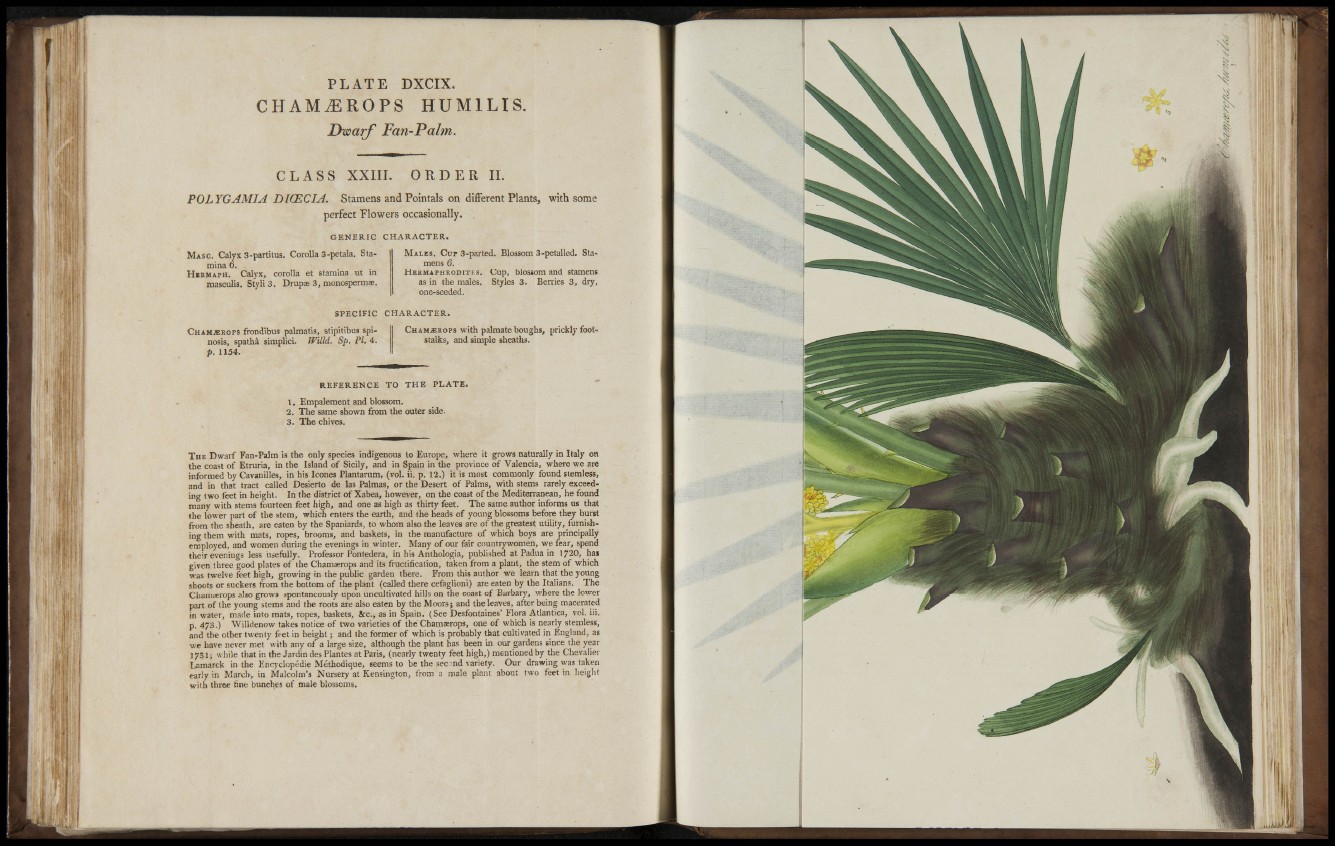
f P L A T E DXCIX.
C H A M t E R O P S H U M I L I S .
J D w a r f F a n - P a lm.
I
•-M Î
'i • -.Mi
C L A S S XXIIL O R D E R IL
FOLYGAMIA DICECIA. Stamens and Pointals on different Plants, with some
perfect Flowers occasionally.
GENERIC CHARACTER.
MASC. Calyx 3-partitus. Corolla 3-petala. Stamina
6.
HERMAPH. Calyx, corolla et stamina ut in
niasculis. StyliS. Drupse 3, monosperm®.
MALES. CUP 3-parted. Blossom 3-petalled. Stamens
6.
HBEMAPHRODITES. Cup, blossom and stamens
as in the males. Styles 3. Berries 3, dry,
one-seeded.
SPECIFIC CHARACTER.
I •tilJill
. r'i ..¿Pii,l''
.isii iiv, •
; îflîtr.^
•'.I Ï:
CHAM«ROPS frondibus palmatis, stlpitibus spinosis,
spathâ simplici. IVilld. Sp. PI. 4.
p. 1154.
CHAM^ROPS with palmate boughs, prickly footstalks,
and simple sheaths.
REFERENCE TO THE PLATE.
1. Empalement and blossom.
2. The same shown from the outer side.
3. The chives.
THE Dwarf Fan-Palm is the only species indigenous to Eurojîe, where it grows naturally in Italy on
the coast of Etruria, in the Island of Sicily, and in Spain in the province of Valencia, where we are
informed by Cavanilles, in his Icones Plantarum, (vol. ii. p. 12.) it is most commonly found stemless,
and in that tract called Desierto de las Palmas, or the Desert of Palms, with stems rarely exceeding
two feet in height. In the district of Xabea, however, on the coast of the Mediterranean, he found
many with stems fourteen feet high, and one as high as thirty feet. The same author informs us that
the lower part of the stem, which enters the earth, and the heads of young blossoms before they burst
from the sheath, are eaten by the Spaniards, to whom also the leaves are of the greatest utility, furnishing
them with mats, ropes, brooms, and baskets, in the manufacture of which boys are principally
employed, and women during the evenings in winter. Many of our fair countrywomen, we fear, spend
their evenings less usefully. Professor Pontederà, in his Anthologia, published at Padua in 1720, has
given three good plates of the Chamsçrops and its fructification, taken from a plant, the stem of which
was twelve feet high, growing in the public garden there. From this author we learn that the young
shoots or suckers trom the bottom of the plant (called there cefaglioni) are eaten by the Italians. The
ChamEerops also grows spontaneously upon uncultivated hills on the coast of Barbary, where the lower
pai-t of the young stems and the roots are also eaten by the Moors; and the leaves, after being macerated
in water, made into mats, ropes, baskets, &c., as in Spain. (See Dcsfontaines' Flora Atlantica, vol. iii.
p. 473.) WilWenow takes notice of two varieties of the Chamserops, one of which is nearly stemless,
and the other twenty fe-et in height ; and the former of which is probably that cultivated in England, as
we have never met with any of a large size, although the plant has been in our gardens since the year
3 731; while that in the Jardin des Plantes at Paris, (nearly twenty feet high,) mentioned by the Chevalier
Lamarck in the Encyclopédie Méthodique, seems to be the sec nd variety. Our drawing was taken
early in March, in Malcolm's Nursery at Kensington, from a male plant about two feet in height
with three fine bunches of tnale blossoms.